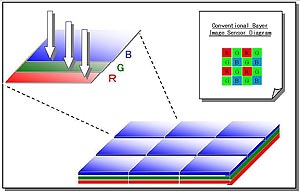 PRESS RELEASE: Fujitsu Launches New Image-Processing LSI Chip for High-Resolution Digital Cameras Compatible with X3 Sensors
PRESS RELEASE: Fujitsu Launches New Image-Processing LSI Chip for High-Resolution Digital Cameras Compatible with X3 Sensors
Industry's first LSI chip for leading-edge image sensors.
Tokyo, March 9, 2007 -- Fujitsu Limited today announced the release of its new LSI image-processing chip MB91680A-T, for use with cutting edge Foveon X3 image sensors and 3CCD technology, as a new addition to Fujitsu's Milbeaut™ line of advanced image processing LSI chips for digital cameras, which includes the flagship model MB91680. The new chip enables sharp, high-quality images to be processed in cameras in real time with low power consumption, thereby offering leading-class performance.
Fujitsu's Milbeaut line of advanced image processing LSI chips combines functions necessary for image processing in digital cameras, such as image compression and noise reduction, in a single chip. The product line is widely implemented in digital cameras and mobile phones.
In addition to being compatible with conventional single layer Bayer pattern(1) image sensors, the MB91680A-T model is also compatible with the cutting-edge Foveon X3 CMOS sensor developed by US-based Foveon Inc. and 3CCD technology found in high performance video cameras. This enables sharp, high-quality image processing in digital single-lens reflex cameras and other high image quality digital cameras in real-time and with low power consumption. These features, combined with the functions found in previous models, deliver the highest performance standards in the industry.
Additionally, the validated TRUE™ (2) image processing system LSI chip jointly developed with Sigma Corporation is used for interconnect to the Foveon X3 CMOS sensor. The MB91680A-T chip was developed in cooperation with Fujitsu VLSI Limited and Fujitsu Micro Solutions Limited.
Sample Pricing and Availability
Product : MB91680A-T
Sample price : 4,000 yen
Availability : From March 9, 2007
Sales Targets
300,000 chips/month
Product Features
1. Compatible with cutting-edge image sensors
Compared to conventional single-layer Bayer pattern image sensors, Foveon X3 sensors have unique color and readout characteristics that pose different challenges for camera system developers. The newly released Fujitsu processor enables seamless connection to the Foveon sensor through the use of sophisticated image processing functions, including various noise reduction methods and new multi-axis color transformation(3) technology embedded into the circuitry.
The result is low noise and high color reproductivity, enabling high-resolution images that take full advantage of the Foveon X3 sensor's features.
2. Utilizes state-of-the-art algorithm that enables beautiful, detailed images
Utilizes the latest image processing algorithm for high performance digital cameras:
- Enables beautiful, detailed, high resolution images
- Controls reflected noise(4) and color noise that occur when CCDs and other imaging devices reach maximum resolution
- Equipped with a color conversion function: able to convert colors into other desired colors
3. Faster speed made possible with cutting-edge FR80 CPU core
Fujitsu's FR series high-performance 32 bit RISC microcontrollers are embedded in Fujitsu's Milbeaut series. The MB91680A-T model employs the FR80, enabling it to execute internal data transfers at approximately four times the efficiency of earlier models, as well as high-speed data transfer of large volumes of data.
Foveon X3 Sensor
Unlike conventional Bayer pattern image sensors, which detect red (R), green (G), and blue (B) light through mosaic patterned filters and detect one color per pixel location, the Foveon X3 sensor (see Figure 1) detects all three colors at each pixel location, avoiding the discoloration that occurs with Bayer filters. Furthermore, it is an ideal sensor in that it eliminates the need for a low-pass filter(5), resulting in a clearer image.

Figure 1: Foveon X3 Image Sensor Diagram
Glossary
1 Bayer pattern: A single-layer pattern in which red, green and blue filters are combined in a mosaic pattern.
2 TRUE™: Three-layer Responsive Ultimate Engine: An advanced image processing LSI chip compatible with Foveon Inc.'s X3 CMOS sensor technology. This chip was jointly developed by Fujitsu Limited and Sigma Corporation. TRUE™ is a trademark of Sigma Corporation.
3 Multi-axis color transformation function: A function that enables adjustments of specified colors by focusing on them individually, without impacting other colors.
4 Reflected Noise: Noise that results from pixels interfering with one another, resulting in patterns that do not actually exist.
5 Low-pass filter: A filter that permits only low frequencies to pass through.
About Fujitsu
Fujitsu is a leading provider of customer-focused IT and communications solutions for the global marketplace. Pace-setting device technologies, highly reliable computing and communications products, and a worldwide corps of systems and services experts uniquely position Fujitsu to deliver comprehensive solutions that open up infinite possibilities for its customers' success. Headquartered in Tokyo, Fujitsu Limited (TSE:6702) reported consolidated revenues of about 4.8 trillion yen (US$40.6 billion) for the fiscal year ended March 31, 2006. For more information, please see: http://www.fujitsu.com
(First posted on Saturday, March 10, 2007 at 11:25 EST)